Alemanni › Vikings » Ancient origins
Articles and Definitions › Contents
- Alemanni › Ancient History
- Vikings › Antique Origins
Ancient civilizations › Historical and archaeological sites
Alemanni › Ancient History
Definition and Origins
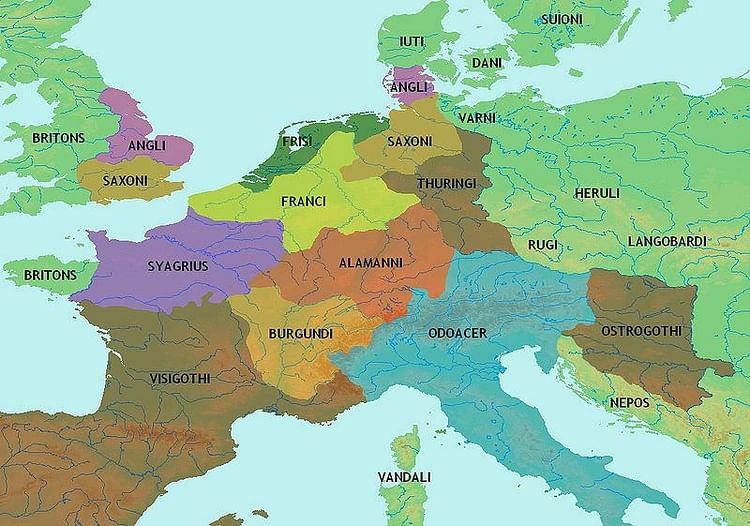
The Alemanni (also known as the Alamanni and the Alamans, meaning "All Men" or "Men United") were a confederacy of Germanic-speaking people who occupied the regions south of the Main and east of the Rhine rivers in present-day Germany.Many historians claim that the Alemanni first enter the historical record in 213 CE when Cassius Dio records the campaigns of Caracalla and his duplicitous dealings with the Alemanni. It is true that the name "Alemanni" first appears in Cassius Dio but, if one accepts that the Alemanni and the Suebi (or Suevi, who appear in earlier records) were the same (as not all do), then their first mention comes in 98 CE in Tacitus' Germania. They were a constant threat to the Roman Empire from 213 CE until they were defeated by Julian at the Battle of Strasbourg in 357 CE and then again by Valentinian I in 367 CE. After the Battle of Strasbourg, Julian entered into treaties with the Franks of Gaul who were then left alone by Rome. They were able to stabilize their communities and grow in power until, in 496 CE, the Frankish king Clovis conquered the Alemanni tribes and absorbed them into his kingdom. After this, their name lived on in the language of the region they had once inhabited and in the name given to Germany, Allemagne, in French and other languages.
THE ALEMANNI WERE STILL A FORMIDABLE FORCE WHEN THEY JOINED THE FORCES OF ATTILA THE HUN AND BATTLED THE ROMANS IN 451 CE.
APPEARANCE & RELIGION
The Roman senator and historian Tacitus (56-117 CE) wrote of the Suevi in the 1st century CE, claiming they controlled the better part of the region known as Germania. He links the Alemanni with the Hermunduri, another Germanic tribe, but this claim has been contested by modern-day scholarship. The Suevi Tacitus depicts sound very much like the later Alemanni, in that they were a confederation of different tribes, which may have even included the Cherusci (famous for their leader Arminius ' destruction of Varus' three legions in Teutoburger Wald in 9 CE). Tacitus is the first writer to note the Suevi's distinctive hair styles and religious practices. He writes:
We have now to speak of the Suevi; who do not compose a single state, like the Catti or Tencteri, but occupy the greatest part of Germany and are still distributed into different names and nations, although all hearing the common appellation of Suevi. It is characteristic of this people to turn their hair sideways, and tie it beneath the poll in a knot.By this mark the Suevi are distinguished from the rest of the Germans; and the freemen of the Suevi from the slaves. Among other nations, this mode, either on account of some relationship with the Suevi, or from the usual propensity to imitation, is sometimes adopted; but rarely, and only during the period of youth.The Suevi, even till they are hoary, continue to have their hair growing stiffly backwards, and often it is fastened on the very crown of the head. The chiefs dress it with still greater care and in this respect they study ornament, though of an undebasing kind. For their design is not to make love, or inspire it; they decorate themselves in this manner as they proceed to war, in order to seem taller and more terrible; and dress for the eyes of their enemies (Germania, 38).
Regarding religion, Tacitus writes that the Suevi were pagan and seem to have practiced a form of Druidism. Their chiefs were drawn from a tribe in the confederation known as Semnones who also served as high priests:
The Semnones assert themselves to be the most ancient and noble of the Suevi; and their pretensions are confirmed by religion. At a stated time, all the people of the same lineage assemble by their delegates in a wood, consecrated by the auguries of their forefathers and ancient terror, and there by the public slaughter of a human victim celebrate the horrid origin of their barbarous rites. Another kind of reverence is paid to the grove. No person enters it without being bound with a chain, as an acknowledgment of his inferior nature, and the power of the deity residing there. If he accidentally falls, it is not lawful for him to be lifted or to rise up; they roll themselves out along the ground. The whole of their superstition has this import: that from this spot the nation derives its origin; that here is the residence of the Deity, the Governor of all, and that everything else is subject and subordinate to him. These opinions receive additional authority from the power of the Semnones, who inhabit a hundred cantons, and, from the great body they compose, consider themselves as the head of the Suevi (Germania, 39).
The religious practices centered on chthonic locales, then, where a central deity held sway. Rivers, streams, glades, and valleys were often chosen as sacred ground for the energies which manifested themselves in these locales. As with many other ancient civilizations, the Suevi believed the soul had to cross a body of water to reach the afterlife and that the soul lived on after death. Suevi/Alemanni grave excavations have revealed that they were buried fully dressed and with personal items that they would need in the next world. These burial practices continued after they converted to Christianity sometime between the 6th and 8th centuries CE although, of course, their religious practices changed dramatically.
THE ALEMANNI & ROME
Although the Suevi have been identified with the later Alemanni, historians caution against equating the two without recognizing their differences over the centuries which separate Tacitus' account (98 CE) from Cassius Dio's (c. 229 CE). The scholar Guy Halsall writes, "It is unlikely that the situation which pertained in the mid-first century was at all relevant to the late Roman period. Tacitus' Germania is a minefield probably best avoided [in this regard]" (121). The scholar Peter Heather comments on this also, stating how unified the Alemanni appear in the work of Ammianus Marcellinus (c. 325-391 CE) while, "One of the central points brought home by even the quickest read of Tacitus' Germania is just how fragmented, in political terms, the Germanic world was at that date" (36). It is for this reason that historians usually cite Cassius Dio's account as the first mention of the Alemanni and ignore Tacitus' earlier description of the Suevi.
By the time of Dio's account, the Alemanni were largely Romanized from their long acquaintance with the Romans. Halsall writes how, in the border region of the Danube and the Roman Empire,
some of the Alemanni, who it has been suggested were formed at least partly by the Romans themselves from inhabitants of the agri decumates [a term possibly meaning 10 agricultural regions]and authorised barbarian settlers, occupied former Roman villa sites, such as at Wurmlingen in Baden Wurttemberg (128).

Roman Emperor Caracalla
The Alemanni at this time wore Roman attire and emulated Roman social customs. Even so, they were not 'Romans' in the accepted sense of that word and maintained their own language and culture. Therefore, when they asked the emperor Caracalla for help against a neighboring tribe in 213 CE, he saw no reason why he should not conquer them instead. Cassius Dio writes:
Antoninus [Caracalla] made a campaign against the Alamanni and whenever he saw a spot suitable for habitation, he would order, "There let a fort be erected. There let a city be built." And he gave these places names relating to himself, though the local designations were not changed; for some of the people were unaware of the new names and others supposed he was jesting. Consequently he came to feel contempt for these people and would not spare even them, but accorded treatment befitting the bitterest foes to the very people whom he claimed to have come to help. For he summoned their men of military age, pretending that they were to serve as mercenaries, and then at a given signal — by raising aloft his own shield — he caused them all to be surrounded and cut down, and he sent horsemen round about and arrested all the others (78.13.4).
Whether the Alemanni were particularly hostile to Rome before this is not known, but they became one of Rome's most bitter enemies afterwards.
ENGAGEMENTS AGAINST ROME
- 256 CE: Gregory of Tours (c. 538-594 CE) famously wrote of the Alemanni invasion of Gaul in 256 CE under their king Chrocus. Chrocus led his army across the land, destroying the cities, churches, towns, and slaughtering the inhabitants until he was defeated at Arles and executed. Surviving members of his army were then either killed or absorbed into the Roman ranks as mercenaries.
- 259 CE: The Alemanni invaded Italy, ravaging the fertile Po Valley, until they were defeated at the Battle of Mediolanum by a Roman force led by emperor Gallienus.
- 268 CE: The Battle of Benacus was fought in 268/269 CE between the emperor Claudius II (supported by the later Emperor Aurelian) and the Alemanni. The Alemanni, allied with the Juthungi, invaded northern Italy and were met at Benacus by the Roman forces. The Romans again decisively defeated the Alemanni, killing most of them and scattering the rest.
- 271 CE: The Alemanni and Juthungi again invaded Italy, while the emperor Aurelian was busy repulsing Vandals on the Danube frontier. He marched his forces to meet the Alemanni threat but was ambushed and defeated at the Battle of Placentia. This defeat resulted in widespread panic throughout Rome, as the Juthungi marched toward the city which had no sizeable force to protect it. Aurelian regrouped, however, and chased the Juthungi, finally meeting them at the Battle of Fano where he defeated them completely, driving them into the Metaurus River where many of them drowned. The surviving Juthungi then sued for a peace which Aurelian rejected. He pursued them and their Alemanni allies and destroyed most of the force at the Battle of Pavia. Those Alemanni who survived were hunted down and killed trying to escape back home through the province of Raetia. Although he had stopped the invasion and destroyed the enemy, Aurelian recognized the need for better defenses for Rome and so ordered a new and stronger wall built around the city.
- 298 CE: The emperor Constantius defeated the Alemanni twice at the Battle of Lingones and then again at the Battle of Vindonissa.
- 356 CE: Julian, commanding his first military force (prior to becoming emperor), was surprised and defeated by the Alemanni at the Battle of Reims.
- 357 CE: Julian defeated the Alemanni at the Battle of Strasbourg, completely overwhelming their forces and capturing one of their most important leaders, Chnodomar (also known as Chnodomarius) who had mobilized the Alemanni for battle and led them from the front. Although Julian's victory subdued the Alemanni and allowed him to march into Germania, re-build and garrison Roman forts, and force tribute from the tribes, it did not destroy the Alemanni or disperse them. Peter Heather writes:
The defeat of Chnodomarius did not mean the total destruction of the alliance at whose head he had stood, as the defeats of his first-century counterparts such as Arminius and Maroboduus had done three centuries before.Not only were many of the lesser Alamannic kings who had participated in the battle left in place by Julian's diplomacy, but, within a decade of the battle, a new pre-eminent leader, Vadomarius, was worrying the Romans.He was skillfully removed by assassination, but then a third appeared in his place: Macrinus. Ammianus records three separate attempts by one of Julian's successors, Valentinian I, to eliminate Macrinus by capture and/or assassination, but eventually, pressed by events further east, the emperor gave in. Roman and Alamann met in the middle of the Rhine for a water-borne summit, where the emperor acknowledged Macrinus' pre-eminence among the Alamanni. Unlike in the first century, even major military defeat was not enough to destroy the larger Alamannic confederation (40-41).
The "major military defeat" Heather refers to is not only the Battle of Strasbourg but the later Battle of Solicinium in 367 CE, in which Valentinian I defeated the Alemanni in the southwestern region of Germany. Even though he was victorious, the Alemanni were by no means broken and were still a formidable force some 80 years later when they joined the forces of Attilathe Hun and took part in the Battle of the Catalaunian Plains against the Romans under Flavius Aetius in 451 CE. Even so, the Battle of Strasbourg severely limited their abilities to threaten Rome for years after. The historian Roger Collins writes,
This single battle really turned the tide as far as the Alaman penetration of Gaul was concerned. It broke the Alamannic confederacy of tribes that had largely been built up and held together by the military credibility of Chnodomar, and for the first time enabled the Romans to take the initiative…Threatened with a Roman invasion of their own territory, the Alamans sought a truce (35).
Again, however, it must be noted that the confederacy was not disbanded nor did the Alemanni seem to consider themselves a conquered people.
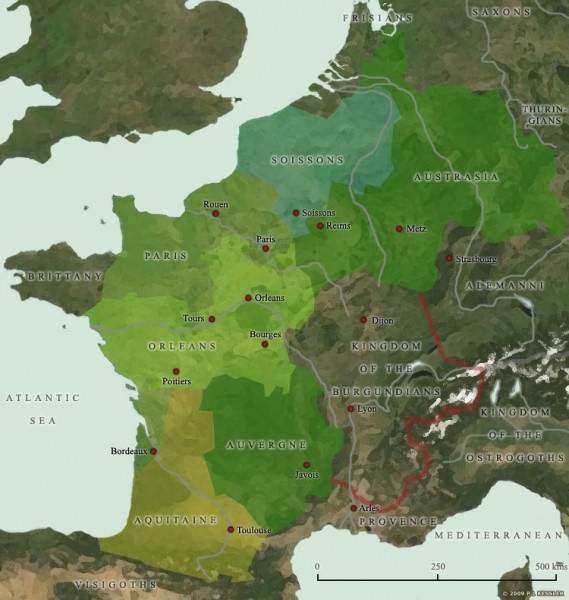
Map of the Frankish Kingdoms AD 511
THE FRANKISH CONQUEST OF THE ALEMANNI
First Julian, and then Valentinian I, entered into treaties with the confederacy of the people known as the Franks ("the fierce people"). In an effort to maintain the newly restored Roman city of Cologne, Julian blockaded the territory of the Franks, depriving them of much-needed trade goods, until they agreed to his terms. Collins comments on this, writing :
It is notable that Julian made no attempt to penetrate the marshy lands north of the Meuse that the Franks had occupied, and their continuing occupation of this area was tacitly accepted by the Romans. From this small start the subsequent Frankish occupation of all of Gaul would develop. This, it might be said, was `the birth of France'.In 357/8, however, what was achieved was a treaty of federation: Frankish occupation of Roman territory was accepted in return for their helping to defend the region (35).
This arrangement was good for the Franks, who began to steadily flourish, but not as beneficial to the Alemanni. By the time the Alemanni fought alongside the Huns in 451 CE at the Catalaunian Plains, the Franks had become powerful enough to be counted as allies of the Romans under Aetius. The Franks were united under the reign of their first king, Clovis I (466-511 CE), who then expanded the boundaries of Gaul to conquer western Europe. The Alemanni continued to inhabit the region of Germania until they were defeated by Clovis I at the Battle of Tolbiac in 496 CE and were subjugated by the Franks.Afterwards, some were assimilated into Frankish culture and took up residence in Gaul, while others continued to live in their former region under Frankish rule. Their name is remembered today in the Alemannic dialect of German, and the word for 'Germany' (Allemagne, Alemania) in many modern-day languages.
Vikings › Antique Origins
Definition and Origins
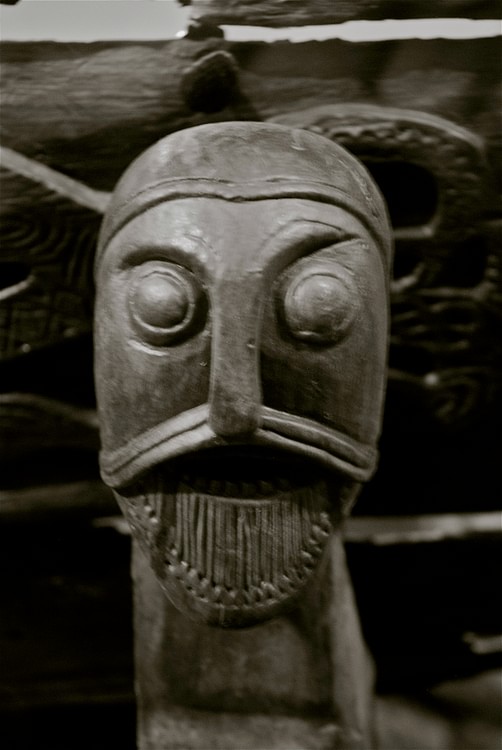
The Vikings were diverse Scandinavian seafarers from Norway, Sweden, and Denmark whose raids and subsequent settlements significantly impacted the cultures of Europe and were felt as far as the Mediterranean regions c. 790 - c. 1100 CE. The Vikings were all Scandinavian but not all Scandinavians were Vikings. The term Viking applied only to those who took to the sea for the purpose of acquiring wealth by raiding in other lands, and the word was primarily used by the English writers, not inclusively by other cultures. Most Scandinavians were not Vikings, and those who traded with other cultures were known as Northmen, Norsemen, or other terms designating their origin.
Beginning in 793 CE and continuing on for the next 300 years, the Vikings raided coastal and inland regions in Europe and conducted trade as far as the Byzantine Empire in the east, even serving as the elite Varangian Guard for the Byzantine Emperor. Their influence on the cultures they interacted with was substantial in virtually every aspect of life, most notably in the regions of Scotland, Britain, France, and Ireland. They founded Dublin, colonized Normandy (land of the Northmen) in France, established the area of the Danelaw in Britain, and settled in numerous communities throughout Scotland.
THE SCANDINAVIAN CULTURE WAS ACTUALLY HIGHLY DEVELOPED & THE VIKING RAIDS ON OTHER NATIONS WERE ONLY ONE ASPECT OF THE CIVILIZATION.
Their settlements in Iceland and Greenland spread Scandinavian culture further across the North Atlantic and placed them in an ideal position for further exploration and colonization. The Vikings were the first Europeans to visit North America and establish communities. The Newfoundland site of L'Anse Aux Meadows has been positively identified as an early Viking settlement while debate continues on other sites from Maine to Rhode Island – and even further south – as evidence of early Viking habitation or at least visitation in North America.
Although popularly imagined as warriors wearing horned helmets, this is inaccurate. Horned helmets would have been impractical in battle and were most likely only worn for ceremonial purposes. Further, although the Vikings were great warriors and their name in the present day is almost synonymous with warfare, slaughter, and destruction – an association encouraged by popular media representations – but the Scandinavian culture was actually highly developed and the Viking raids on other nations were only one aspect of the civilization.
NAME
The origin of the word 'Viking' is still debated by scholars. Professor Kenneth W. Harl represents the traditional view that Viking “comes from the Norse vik, meaning a cove or small fjord, a place where pirates could lurk and prey on merchant ships” (3).The philologist Henry Sweet claims the word derives from the Old Norse for “pirate” (Whitelock, 222). Professor Peter Sawyer argues that the word must come from the region of Viken, which flanked the Oslo Fjord, writing :
This district was of great value for it was there that the Danes could obtain the iron that was produced in Norway.If, as seems likely, the word Viking originally referred to the inhabitants of Viken, it could explain why the English, and only they, called Scandinavian pirates Vikings, for England was the natural objective for men from Viken who chose exile as raiders. (8)
Sawyer points out that other cultures all referred to these same people by different names – but none called them Vikings. The Irish records call them pagans or simply foreigners, the French called them Northmen, the Slavs called them the Rus (which gave Russia its name), and the Germans knew them as Ashmen in reference to their use of ash wood for their boats.
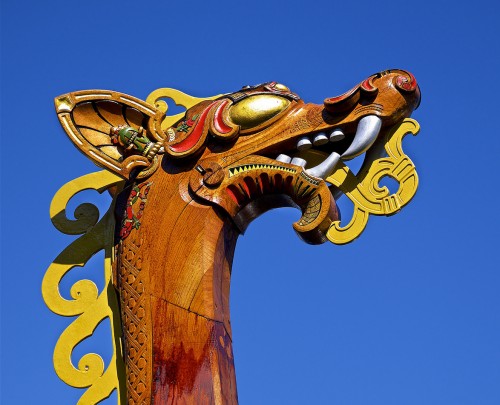
Viking Boat Figurehead
The Vikings used the word themselves to refer to the activity of armed raids on other lands for the purpose of plunder. The Old Norse phrase fara i viking (“to go on expedition”) had a distinctly different meaning than going on a sea voyage for the purposes of legitimate trade. When one decided to “go Viking” one was announcing one's intention to join in raiding profitable targets in other lands.
CULTURE
The Viking culture was Scandinavian, with society divided into three classes, the Jarls (aristocracy), Karls (lower class), and Thralls (slaves). Upward mobility was possible for Karls but not Thralls. Slavery was widely practiced throughout Scandinavia and is considered one of the prime motivators for the Viking raids on other lands.
SLAVERY WAS WIDELY PRACTICED THROUGHOUT SCANDINAVIA & IS CONSIDERED ONE OF THE PRIME MOTIVATORS FOR THE VIKING RAIDS ON OTHER LANDS.
Women had greater freedoms in Scandinavian/Viking culture than in many others. Women could inherit property, choose where and how to live if unmarried, represent themselves in legal cases, and own their own businesses (such as breweries, taverns, shops, and farms). Women were the prophetesses of either the goddess Freyja or the god Odin – there were no male religious leaders – and interpreted the gods' messages for the people.
Marriages were arranged by the men of the clan, and a woman could not choose her own mate - but neither could a man.Women's dress and jewelry were similar to men of their social class, and neither sex wore earrings which were thought to be affectations of lesser races. Women were responsible for raising children and keeping the house but both men and women prepared meals for the family.
Most Scandinavians were farmers, but there were also blacksmiths, armorers, brewers, merchants, weavers, luthiers (those who made stringed instruments), drum-makers, poets, musicians, craftsmen, carpenters, jewelers, and many other occupations. A significant source of income was trading amber, the fossilized resin of the pine tree, which they had in abundance. Amber frequently washed up on the shores around Scandinavia and was worked into jewelry or sold in semi-processed form, especially to the Roman and Byzantine empires.
Scandinavians enjoyed leisure time as much as any other culture and played sports, board games, and organized festivals.Sports included mock-combat, wrestling, mountain climbing, swimming, javelin-throwing, hunting, a spectacle known as horse-fighting whose details are unclear, and a field game known as Knattleik which was similar to hockey. Their board games included dice, games of strategy along the lines of chess, and chess itself.
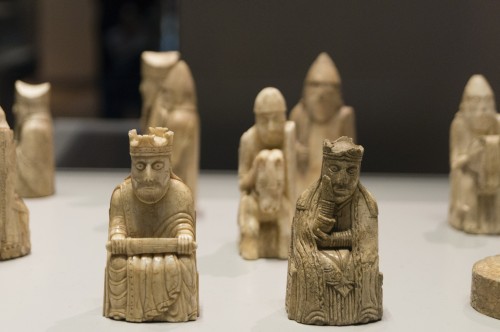
Lewis Chessmen
Contrary to the popular image of the Vikings as filthy and savage, they were actually quite refined and paid a great deal of attention to hygiene and appearance. Once trade was established with the east, Viking Jarls often wore silk and expensive jewelry. They braided their hair, were well groomed, and wore fine cloaks and intricately-crafted jewelry in the form of necklaces and arm- and wristbands.
Cleanliness was not only a sign of wealth and status but also had religious significance. Vikings made sure to always keep their finger and toenails short because of their belief in Ragnarok, the twilight of the gods and the end of the world, at which the ship Naglfar would appear floating on the waters unleashed by the great serpent Jormungand. Naglfar was built from the nails of the dead and so anyone who died with nails unpared provided ship-building material and hastened the inevitable end.
NORSE RELIGION
The end of the world was predestined but one could still struggle against it. The gods of the Norse provided the people with the breath of life, and it was then up to each individual to prove worthy of the gift. The Norse gods came to Scandinavia with the Germanic migrations sometime around the beginning of the Bronze Age (c. 2300 - c.1200 BCE). These were fierce gods who understood their time was limited and lived fully to make the most of it; their followers were encouraged to do the same.
The main sources for the Norse religious beliefs are the Poetic Edda, dated to oral traditions of the 9th and 10th centuries CE, and the Prose Edda (c. 1220 CE), a collection of tales based on older stories. In the Norse creation story, before the world was created there was only ice and a giant named Ymir who lived by the grace of the great cow Audhumla. Audhumla fed Ymir milk which ran continuously from her four udders while, at the same time, licking the ice for her own sustenance. Her licking freed the trapped god Buri who then produced a son, Borr.

Codex Regius of the Poetic Edda
Borr married Bestla, daughter of Bolthorn the frost giant, and she gave birth to the gods Odin, Vili, and Vé. These gods united, killed Ymir, and used his body to create the world. The first human beings were Ask and Embla, who had no spirit or form until life was breathed into them by Odin, while other gods gave them reason and passion.
The world created by the gods was understood as an enormous tree, known as Yggdrasil, and included nine planes of existence. The most famous of these are Midgard (home for mortals), Asgard (home of the gods), and Alfheim (home of the elves) and another realm, Niflheim, located beneath Midgard where those who died poorly went. Heroic women, especially those who died in childbirth, went to the Hall of Frigg in Asgard where they spent eternity in the company Odin's wife while men who died heroically in battle went to Odin's hall of Valhalla.
The entire universe was established on the principles of order by Odin and the other gods after they had defeated the frost giants. The frost giants lived in their own realm, Jotunheim, but were a constant threat to both Asgard and Midgard. At some point in the future, a great day of destruction would come and chaos would be unleashed; this day was known as Ragnarök, the twilight of the gods.
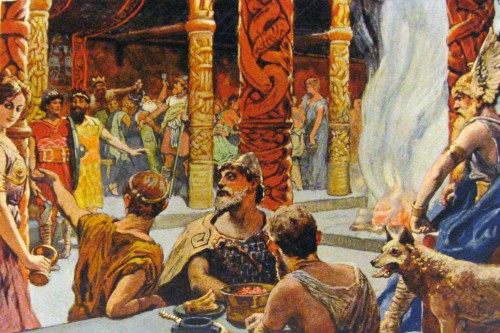
Valhalla
When Ragnarök came, the sun would be swallowed by the wolf Skoll and the moon by his brother Hati, plunging the world into darkness while, at the same time, the great wolf Fenrir would ravage through all the planes of Yggdrasil. The god Heimdall would sound his great horn, calling the gods to battle, and Odin would call up all the heroes from Valhalla's halls to join with the gods in defending creation. The gods fight valiantly but, in the end, they fall in battle as the entire universe is consumed in flame and sinks into the primordial waters. Although this is the end of the world, it is not the end of existence; once this present world is destroyed, a new one is created and rises from the waters and the entire cycle repeats itself.
The Norse gods were honored through the actions of the people who believed in them. No evidence of a religious hierarchy has been found in Scandinavia prior to the coming of Christianity. Women who were touched by the gods were known as Volva and could hear the divine words and translate them for other mortals. Although there were some temples erected to the gods, most worship seems to have taken place in natural settings which had some connection to a certain deity. The stories of the gods, creation, and Ragnarök were transmitted orally and were only written down much later, in Iceland by the historian/poet Snorri Sturluson (1179-1241 CE).
SHIPBUILDING & THE VIKING RAIDS
The Norse mythology would influence the Viking culture and encourage their raids because the Viking life emulated that of the gods. Brave warriors went abroad to do battle against forces they saw as chaotic and dangerous. The Mediterranean and European religious belief in a single god and his savior son who needed priests, churches, nuns, books, and rules to be worshipped would have seemed absurd and threatening to the Vikings. There was nothing in the Christian teaching which resonated with Norse ideology. Once the Scandinavians had fully mastered shipbuilding and began to “go Viking,” they showed no mercy to the Christian communities they encountered, but early Scandinavian settlers in foreign lands frequently adopted the new faith.
Carvings from Scandinavia dated to c. 4000-2300 BCE show that the people already knew how to build boats at this time.These small ships were driven by paddles, had no keel, and would have made long-distance trips perilous; still, there is ample evidence that such journeys were made. Shipbuilding developed past this stage of small ferry boats only around c. 300-200 BCE and would not develop further until interactions with Roman traders and Celtic and Germanic merchants using Roman technology between c. 200-400 CE. The first ship able to navigate the sea easily is known as the Nydam ship, from Denmark, built c. 350-400 CE, though this ship had no sail.
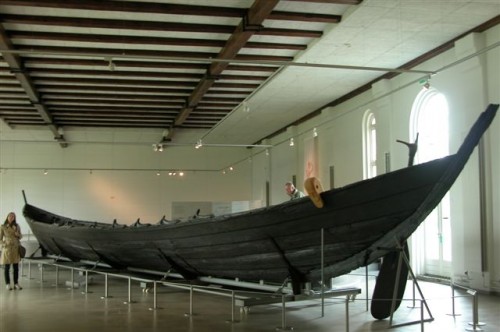
Nydam Ship
Long before the development of keel or sail, however, a number of Scandinavian traders established permanent communities in Europe and assimilated with the Christian culture, forgetting the stories of the Norse gods and their old religious practices.Professor Harl notes that by 625 CE,
The West Germanic kinsmen of the Scandinavians had converted to Christianity and had begun to forget their own stories. Between 650 and 700 CE, new Christian cultures emerged in England, in the Frankish world, and in Frisia, which led to a parting of the ways between the Scandinavian heartland and the new states in the former Roman Empire. (25)
This “parting of the ways” was largely due to differences in religious understanding and behavior. The Christian god was supposed to be omnipotent, omniscient, and omnipresent and this was a significant departure from the Norse gods who, like other pagan religions, each had their own area of expertise, their own lives and concerns, and whose actions explained the observable world in a way the Christian god did not. For the Vikings, the universe was full of gods and spirits and supernatural energies which infused a challenging world of adventure while, to the Christians, it was ruled by one deity who presided over a fallen world of sin; this difference in world views influenced how the Vikings dealt with the Christians they encountered on their raids.
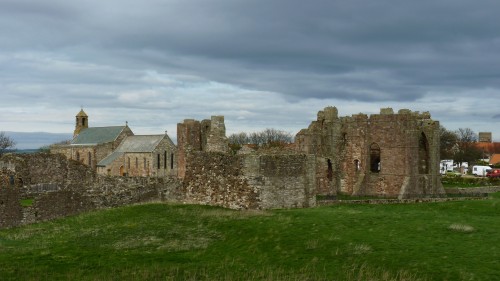
Lindisfarne
It would have been considered dishonorable for a Norse warrior to kill unarmed civilians and take their possessions, but this is precisely what the Vikings did between c. 793-1100 CE. They were able to do so because those they plundered were not Norse, were not bound by the same belief, and so the rules which maintained Viking society did not apply to them. When the Vikings first came to Britain and sacked the priory of Lindisfarne in 793 CE, they murdered every monk they found and carried off everything of value; this would have been considered a serious crime if the slain had been Norse, but as it was, the monks were simply obstacles to the acquisition of wealth and, further, it was abundantly clear that the Christian god had no power to defend his people if they could so easily be killed within the walls of their own place of worship.
EXPANSION & LEGACY
The Viking raids on Christian communities, like those of the Huns on the Roman Empire centuries earlier, were interpreted by European Christians as God's wrath on his people for their sins. In Britain, Alfred the Great (871-899 CE) would institute his reforms in education to better his people and appease his God. He also made baptism into the Christian faith a stipulation of treaties with the Vikings. When Alfred defeated the Viking army under Guthrum at the Battle of Eddington in 878 CE, Guthrum and 30 of his chieftains had to submit to baptism and conversion.
Charlemagne in France (800-814 CE) pursued a much more active course in attempting to forcefully Christianize the Scandinavians through military campaigns which destroyed sites sacred to Norse belief and established Christianity as an enemy faith of a hostile people. Charlemagne's efforts have been cited by a number of historians as the primary motivation for the savagery of the Viking raids, but this claim does not take into account the raids on Britain and Ireland between 793-800 CE. There is little doubt, however, that Charlemagne's evangelical holy wars did little to encourage Scandinavian acceptance of Christianity and only led to animosity and greater division.
In the early years of the Viking Age in Europe, the sea-raiders began as little more than pirates, but they would eventually arrive as great armies under charismatic and skilled military leaders, would conquer large territories and establish communities, and finally would assimilate with the local population. The Viking Age is known for legendary Norse leaders such as Halfdan Ragnarsson (also known as Halfdane, c. 865-877 CE), his brother Ivar the Boneless (c. 870 CE), Guthrum (c. 890 CE), Harold Bluetooth (c. 985 CE), his son Sven Forkbeard (986-1014 CE), Cnut the Great (1016-1035 CE) and Harald Hardrada (1046-1066). Other notable Norse explorers of the time were Eric the Red (died 1003 CE) and Leif Erikson (died c. 1020 CE) who explored and settled Greenland and North America.
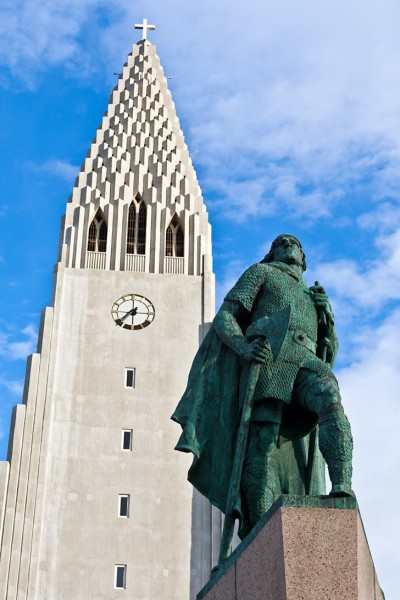
Leif Erikson
The Vikings were never defeated en masse in battle and no single engagement ended the Viking Age. The date agreed on by most scholars as the end of the Viking Age is 1066 CE when Harald Hardrada was killed at the Battle of Stamford Bridge, but Viking raids continued after this date. There were many factors which contributed to the end of the Viking Age but the Christianization of Scandinavia throughout the 10th and 11th centuries CE was certainly among the most significant. The Norse religion was the last of the great pagan belief systems to fall to Christianity, and once it did, there was no inspiration in the new faith for one to "go Viking" anymore.
The Vikings influenced the culture of every nation they came in contact with and in every conceivable way from architecture to language, infrastructure to poetry and place names, military reforms to food and clothing, and certainly in the areas of warfare and shipbuilding. Regularly depicted by medieval writers as marauding bands of murderous heathens, the Vikings would be re-imagined as noble savages by the early 20th century CE, and this is often how they are still portrayed in the present day. The Vikings were actually neither of these, however; they were a cultured and sophisticated warrior class who understood, based on their religious belief, that in raiding other lands for personal gain they had everything to win and nothing to lose.
LICENSE:
Article based on information obtained from these sources:with permission from the Website Ancient History Encyclopedia
Content is available under License Creative Commons: Attribution-NonCommercial-ShareAlike 3.0 Unported. CC-BY-NC-SA License